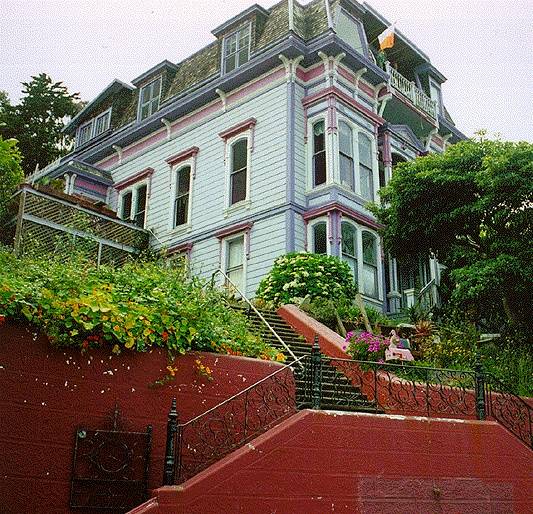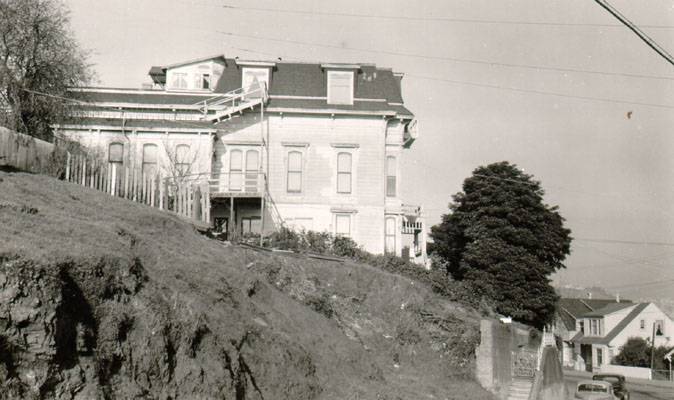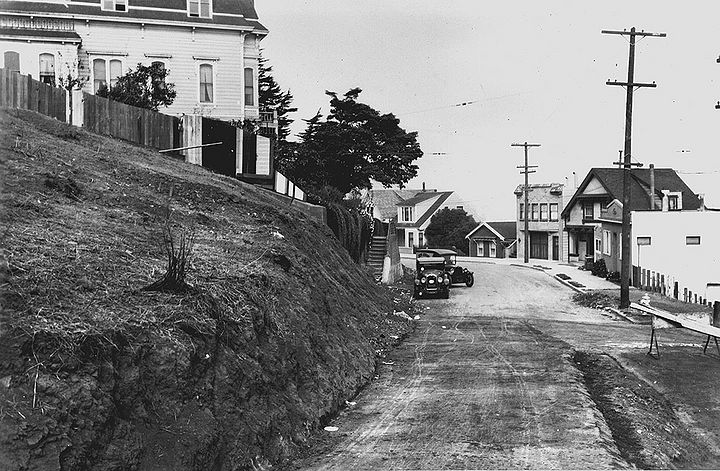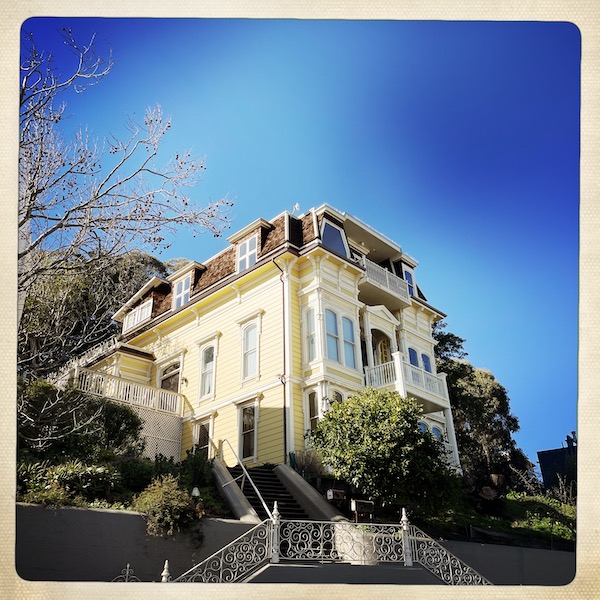Fairmount Heights: Difference between revisions
added new photo |
mNo edit summary |
||
| (6 intermediate revisions by 2 users not shown) | |||
| Line 5: | Line 5: | ||
[[Image:glenpark$poole-bell-house.jpg]] | [[Image:glenpark$poole-bell-house.jpg]] | ||
'''Poole-Bell House: 196 | '''Poole-Bell House: 192-196 Laidley St. A house with a mysterious past linked to a controversial triangle: Thomas Bell, Teresa Bell, and [[Mary Ellen Pleasant |Mary Ellen Pleasant]], an early Black activist and shrewd businesswoman (who actually never lived in the house). John P. Poole, an attorney, first owned the house, then his widow Annie and later Teresa Bell were owners.''' | ||
''Photo: David Green'' | ''Photo: David Green, 1996'' | ||
[[Image:Teresa Bell residence 198 Laidley c 1959 AAC-5906.jpg]] | [[Image:Teresa Bell residence 198 Laidley c 1959 AAC-5906.jpg]] | ||
'''Same house at | '''Same house at 192–196 Laidley, 1959.''' | ||
''Photo: San Francisco History Center, San Francisco Public Library'' | ''Photo: San Francisco History Center, San Francisco Public Library'' | ||
[[Image:Laidley-St-north-at-Fairmount-w-Bell-Mansion-Nov-2-1928-SFDPW.jpg|720px]] | |||
'''Laidley Street north at Fairmount, Poole-Bell House at left, November 2, 1928.''' | |||
''Photo: SFDPW, courtesy C. R. collection'' | |||
[[Image:Poole-Bell House Fairmount Heights January 2023 72 dpi-lisaruth elliott.jpeg]] | |||
'''As seen in January 2023, after considerable rehabilitation and renewal.''' | |||
''Photo: LisaRuth Elliott'' | |||
While Fairmount Heights was not part of Horner's Addition, as an adjacent area it enjoyed a similar kind of growth as did Eureka and Noe Valley's. In 1959 residents of Fairmount Heights and Upper Noe Valley formed a committee to research its neighborhood history. These are excerpts from their colorful findings. | While Fairmount Heights was not part of Horner's Addition, as an adjacent area it enjoyed a similar kind of growth as did Eureka and Noe Valley's. In 1959 residents of Fairmount Heights and Upper Noe Valley formed a committee to research its neighborhood history. These are excerpts from their colorful findings. | ||
| Line 32: | Line 43: | ||
"In 1896, there were 20 telephones in the neighborhood, which were advertised in the phone book as pay phones (5 cents) even though some were in private homes. | "In 1896, there were 20 telephones in the neighborhood, which were advertised in the phone book as pay phones (5 cents) even though some were in private homes. | ||
Building in the area continued and flats were constructed instead of individual homes. One of the most unique of these was the Romeo type. These were two or three stories in height. A good example is on Noe near 29th Street. This three-story building has an open stairway in the middle of the building and two entrances on each level. A flight of stairs winds up to overlooking the sidewalk where latter day Juliets can call to their Romeos. | "Building in the area continued and flats were constructed instead of individual homes. One of the most unique of these was the Romeo type. These were two or three stories in height. A good example is on Noe near 29th Street. This three-story building has an open stairway in the middle of the building and two entrances on each level. A flight of stairs winds up to overlooking the sidewalk where latter day Juliets can call to their Romeos. | ||
Building in the Upper Noe Valley continued and included houses with marble stairs and wooden columns. Some of these were two stories with the bedrooms on the second floor. They had either three flat windows or three bay windows and were built from 1907 to 1916. During the same period, sewers, streets, and sidewalks were installed, one or two blocks at a time. | "Building in the Upper Noe Valley continued and included houses with marble stairs and wooden columns. Some of these were two stories with the bedrooms on the second floor. They had either three flat windows or three bay windows and were built from 1907 to 1916. During the same period, sewers, streets, and sidewalks were installed, one or two blocks at a time. | ||
About 1910, gas streetlights were installed requiring manual lighting. The lamplighter was an important part of children's lives because they were allowed to play outside until dusk when he came around to light the street lights. With a kerosene lighter on a long pole, he opened the bottom of the street lamp and lit the wick inside. Also at this time people started to install gas in their homes, but wood and coal stoves, with water backs, were used until the 1930s to heat water for bathing and washing. | "About 1910, gas streetlights were installed requiring manual lighting. The lamplighter was an important part of children's lives because they were allowed to play outside until dusk when he came around to light the street lights. With a kerosene lighter on a long pole, he opened the bottom of the street lamp and lit the wick inside. Also at this time people started to install gas in their homes, but wood and coal stoves, with water backs, were used until the 1930s to heat water for bathing and washing. | ||
A theatre was constructed at 28th and Church Streets in 1916, and was known by the names Rita, New Rita, and the Princess. It was the old type nickelodeon, with piano playing to accompany the silent films. | "A theatre was constructed at 28th and Church Streets in 1916, and was known by the names Rita, New Rita, and the Princess. It was the old type nickelodeon, with piano playing to accompany the silent films. | ||
"After World War I, there was a shift in population, and new people came into the neighborhood. In the early 1920s, gas lights were converted to electricity in the homes and the streets. People were then able to buy radios, toasters, waffle irons, and other appliances. | "After World War I, there was a shift in population, and new people came into the neighborhood. In the early 1920s, gas lights were converted to electricity in the homes and the streets. People were then able to buy radios, toasters, waffle irons, and other appliances. | ||
In the 1930s, some stores and businesses failed, men were unemployed, families were on relief, men were selling apples on street corners or working at whatever they could do, and rooms in homes were closed off to save | "In the 1930s, some stores and businesses failed, men were unemployed, families were on relief, men were selling apples on street corners or working at whatever they could do, and rooms in homes were closed off to save heat and light. | ||
"In 1935, the Depression was over and people were repairing their homes and buying new cars. The building trades were well represented in Upper Noe Valley and Fairmount Heights as were civil service workers, waitresses, and miscellaneous trades and crafts people." | |||
Please see the Sunnyside History Project's well-researched article, [https://sunnysidehistory.org/2020/03/04/bodies-in-the-well-trapdoors-in-the-foyer-how-the-poole-bell-house-became-mired-in-myths/ "Bodies in the Well, Trapdoors in the Foyer: How the Poole-Bell House Became Mired in Myths"] for more on the Poole-Bell House. | |||
[[30th and Noe c 1926| Prev. Document]] [[Diamond Heights | Next Document]] | [[30th and Noe c 1926| Prev. Document]] [[Diamond Heights | Next Document]] | ||
[[category:Glen Park]] [[category:Noe Valley]] [[category:1860s]] [[category:1870s]] [[category:1880s]] [[category:1890s]] [[category:1900s]] [[category:1910s]] [[category:1920s]] [[category:1930s]] [[category:1940s]] | [[category:Glen Park]] [[category:Noe Valley]] [[category:1860s]] [[category:1870s]] [[category:1880s]] [[category:1890s]] [[category:1900s]] [[category:1910s]] [[category:1920s]] [[category:1930s]] [[category:1940s]] [[category:Irish]] | ||
Latest revision as of 12:53, 26 January 2023
Historical Essay
by Mae Silver
Poole-Bell House: 192-196 Laidley St. A house with a mysterious past linked to a controversial triangle: Thomas Bell, Teresa Bell, and Mary Ellen Pleasant, an early Black activist and shrewd businesswoman (who actually never lived in the house). John P. Poole, an attorney, first owned the house, then his widow Annie and later Teresa Bell were owners.
Photo: David Green, 1996
Same house at 192–196 Laidley, 1959.
Photo: San Francisco History Center, San Francisco Public Library
Laidley Street north at Fairmount, Poole-Bell House at left, November 2, 1928.
Photo: SFDPW, courtesy C. R. collection
As seen in January 2023, after considerable rehabilitation and renewal.
Photo: LisaRuth Elliott
While Fairmount Heights was not part of Horner's Addition, as an adjacent area it enjoyed a similar kind of growth as did Eureka and Noe Valley's. In 1959 residents of Fairmount Heights and Upper Noe Valley formed a committee to research its neighborhood history. These are excerpts from their colorful findings.
"In 1864, if you took a buggy ride over the dirt roads of San Francisco from downtown to Fairmount Heights, you go out the country road or Mission Street. You would pass Park Street (24th Street), Yolo (25th Street) and Navy (26th Street). At New Market (Army), you would cross a wooden toll bridge that crossed Serpentine Creek and then proceed on to Vale (28th Street), Dale (29th Street), and Grove (30th Street) and end at Palmer (Randall) Streets.
"In about 1871, the street names as we know them started appearing in the plot maps. St. Luke's Hospital was built in 1871 and accommodated 220 patients and 75 infants. You could get your milk at Snowdenhouses' Dairy at 30th and Dolores, at the Del Monte Dairy at 30th and Sanchez, or at Mitchell Dairy at 29th and Noe Streets.
"Somewhere around the 1870s, two schools were built in the Upper Noe Valley--Fairmount. Both were small wooden shacks. One was the original Fairmount School at Randall and Chenery Streets. The other was the Clement School (now Kate Kennedy) at Noe and 30th Streets. In 1876, Father Breslin celebrated the first Mass in St. Paul Parish in a brick building on Noe Street between 28th and 29th Streets. The present steel and stone (quarried from the upper end of 30th Street) church was completed in 1897.
"In 1868, people living in the area were carriage makers, stablers, bankers, civil service workers, painters, and men working in the building trades. In 1877, there were 25 trade unions in the city and their membership totaled 3,500.
"In the 1880s, there was a great deal of building in the Upper Noe and Fairmount area. About one third of our present houses were built at that time. These were built on lots 25x100 feet or sometimes a little longer. The 1880 to 1890 homes have a distinct character of their own. They have a center front stairway with a recessed doorway. The front of the building is composed of a "false front" which extends about three feet above a slight sloped peak roof. There are generally two narrow windows (sometimes only one) on each front side of the building. There is also wood trim around the doors and windows.
"Advertisements in an 1891 newspaper listed lots around Day and Douglass Streets for the price of $200. A home in the vicinity of Church and Duncan Streets was selling for the grand sum of $1,500.
"In 1896, there were 20 telephones in the neighborhood, which were advertised in the phone book as pay phones (5 cents) even though some were in private homes.
"Building in the area continued and flats were constructed instead of individual homes. One of the most unique of these was the Romeo type. These were two or three stories in height. A good example is on Noe near 29th Street. This three-story building has an open stairway in the middle of the building and two entrances on each level. A flight of stairs winds up to overlooking the sidewalk where latter day Juliets can call to their Romeos.
"Building in the Upper Noe Valley continued and included houses with marble stairs and wooden columns. Some of these were two stories with the bedrooms on the second floor. They had either three flat windows or three bay windows and were built from 1907 to 1916. During the same period, sewers, streets, and sidewalks were installed, one or two blocks at a time.
"About 1910, gas streetlights were installed requiring manual lighting. The lamplighter was an important part of children's lives because they were allowed to play outside until dusk when he came around to light the street lights. With a kerosene lighter on a long pole, he opened the bottom of the street lamp and lit the wick inside. Also at this time people started to install gas in their homes, but wood and coal stoves, with water backs, were used until the 1930s to heat water for bathing and washing.
"A theatre was constructed at 28th and Church Streets in 1916, and was known by the names Rita, New Rita, and the Princess. It was the old type nickelodeon, with piano playing to accompany the silent films.
"After World War I, there was a shift in population, and new people came into the neighborhood. In the early 1920s, gas lights were converted to electricity in the homes and the streets. People were then able to buy radios, toasters, waffle irons, and other appliances.
"In the 1930s, some stores and businesses failed, men were unemployed, families were on relief, men were selling apples on street corners or working at whatever they could do, and rooms in homes were closed off to save heat and light.
"In 1935, the Depression was over and people were repairing their homes and buying new cars. The building trades were well represented in Upper Noe Valley and Fairmount Heights as were civil service workers, waitresses, and miscellaneous trades and crafts people."
Please see the Sunnyside History Project's well-researched article, "Bodies in the Well, Trapdoors in the Foyer: How the Poole-Bell House Became Mired in Myths" for more on the Poole-Bell House.




